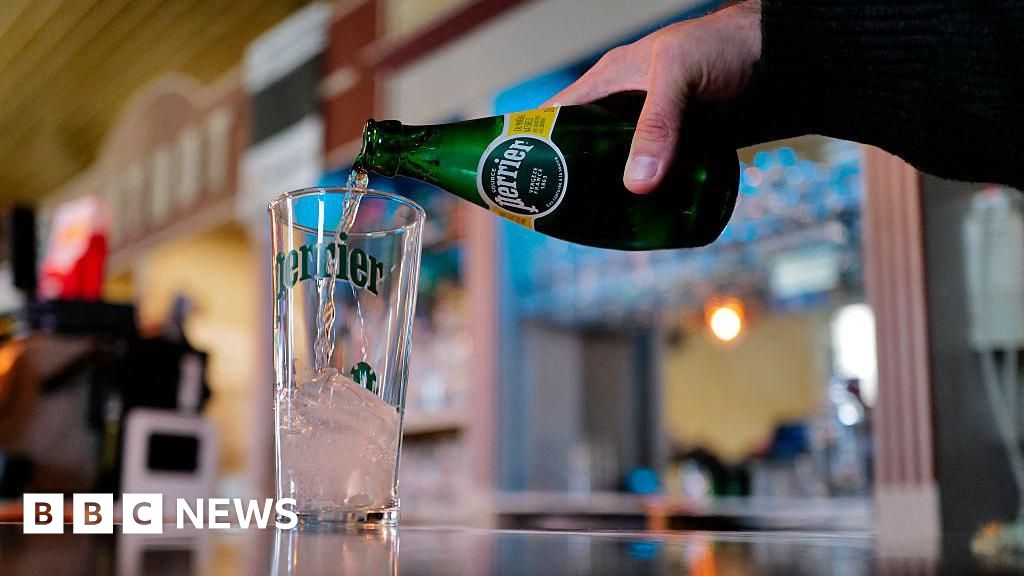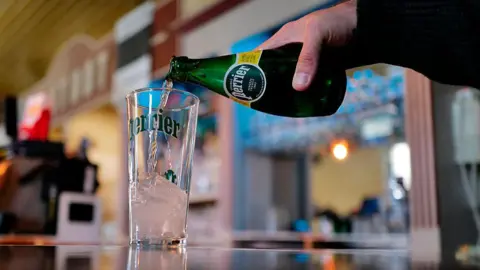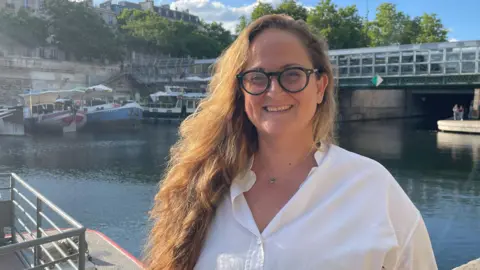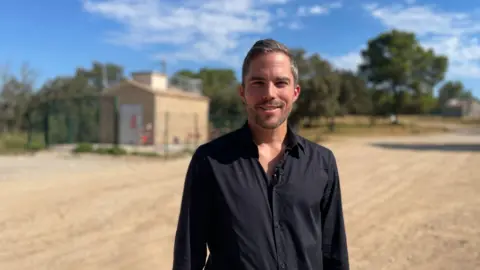Is Perrier as pure as it claims? The bottled water scandal gripping France

Hugh Schofield
Paris correspondent
Reporting fromVergèze

 Getty Images
Getty Images
France’s multi-billion euro mineral water companies are under the spotlight because of climate change and growing concerns about the industry’s environmental impact.
At issue is whether some world-famous brands, notably the iconic Perrier label, can even continue calling themselves “natural mineral water”.
A decision in the Perrier case is due in the coming months. It follows revelations in the French media about illicit filtration systems that have been widely used in the industry, apparently because of worries about water contamination, after years of drought linked to climate change.
“This really is our Water-gate,” says Stéphane Mandard, who has led investigations at Le Monde newspaper. “It’s a combination of industrial fraud and state collusion.”
“And now there is a real Sword of Damocles hanging over the head of Perrier.”
According to hydrologist Emma Haziza, “the commercial model of the big producers has worked very well. But it is absolutely not sustainable at a time of global climate change”.
“When you have big brands that feel they have no choice but to treat their water – that means they know there is a problem with the quality.”

 Getty Images
Getty Images
The story hit the headlines a year ago in France after an investigation by Le Monde and Radio France revealed that at least a third of mineral water sold in France had been illegally treated, either with ultra-violet light, carbon filters or ultra-fine micro-meshes commonly used to screen out bacteria.
The issue was not one of public health. The treated water was by definition safe to drink.
The problem was that under EU law, “natural mineral water” – which sells at a huge premium over tap water – is supposed to be unaltered between the underground source and the bottle. That is the whole point of it.
If brands like Evian, Vichy and Perrier have been so successful in France and around the world, it is thanks to an appealing image of mountain-sides, rushing streams, purity and health-giving minerals.
Admit filtering the water, and the industry risks breaking the market spell. Consumers might begin to ask what they’d been paying for.
Complicating matters for Perrier and its parent company Nestlé – as well as President Emmanuel Macron’s government – is the charge that executives and ministers conspired to keep the affair quiet, covered up reports of contamination, and re-wrote the rules so that Perrier could continue using micro-filtration.
In their investigations, Le Monde and Radio France alleged that the government considered the mineral water industry so strategic that it agreed to suppress damaging information. A senate inquiry into the affair accused the government of a “deliberate strategy” of “dissimulation”.
Responding to the allegations, the government has asked the European Commission to rule on what level of micro-filtration is permissible for “natural mineral water”. Aurelien Rousseau, who was head of Prime Minister Élisabeth Borne’s cabinet at the time, admitted there had been an “error of appreciation” but insisted there was never any risk to public health.

 Getty Images
Getty Images
Earlier this year, at the senate hearing into the industry, Nestlé’s CEO Laurent Freixe admitted that Perrier had indeed used illicit methods to treat its water.
But he also had another admission: that an official hydrologists’ report into the company’s historic site in the Gard department in southern France had recommended against renewing “natural mineral water” status for the company’s output.
It raises the possibility that for the first time in its 160-year history, Perrier water may soon not be labelled as what people assume it to be.
According to the hydrologist Emma Haziza, “the link to climate change and global warming is absolutely established”. And if Perrier is feeling the impact ahead of other companies, it is probably because its geographical location sets it apart.
Far from the remote mountain landscape you might imagine, Perrier’s water is pumped from deep aquifers in the coastal plain between Nîmes and Montpellier, a short drive from the Mediterranean. The area is populous, heavily-farmed, and very hot.
“There has been a big climatic shift since 2017,” says Haziza. “For five years there was a succession of droughts, which were particularly badly felt in the south.”


“All the aquifers were affected. This means not just the upper water-table, which is where everyday tap water comes from. We can now see that the deeper aquifers – which the companies thought were protected – are also being hit.
“The unforeseen is taking place. We are moving from a period in which companies could draw water from the deep aquifers and be sure they would be replenished, to a period in which it’s obvious the whole system cannot go on.”
The analysis made by Haziza and other hydrologists is that there is now a clear link between deeper and surface aquifers. Contaminants (farm chemicals or human waste) that drain off the land in the increasingly frequent flash floods, can now make their way into the lower aquifers.
At the same time, the effects of long-term drought and over-pumping mean these lower aquifers contain less volume, so any contamination will be more concentrated, the experts say.
“We can foresee that what has happened first at Perrier’s site will happen to other producers in the years to come. That’s why we need to move away from our current model of consumption,” says Haziza.


Last year at the Perrier site, three million bottles had to be destroyed because of a contamination. But the company insists that any problems are swiftly detected; and it disputes the claim that contaminants are entering the deep aquifers.
“We are pumping water from 130 metres underground, beneath layers of limestone,” says Perrier hydrologist Jérémie Pralong. “We are 100% convinced of the purity of the water. And its mineral make-up is constant.”
Perrier says there is no EU ruling that specifically bans micro-filtration. The relevant text simply says that nothing must be done to disinfect or alter the mineral make-up of the water. The argument is over at what measure of micro-filtration alteration begins.
The original Perrier source was first tapped by a local doctor in the 1860s, but it was under British management that the brand took off 50 years later.
St John Harmsworth – brother of newspaper magnates Lords Northcliffe and Rothermere – made Perrier a byword for mineral water across the British empire.
According to company lore, Harmsworth took inspiration for the bottles’ bulbous shape from the Indian clubs he used for exercise following a crippling car accident.
Today the bottling plant at Vergèze is still next to Harmsworth’s residence and the original source. The plant has been heavily automated. A rail track connects with the SNCF network to bring hundreds of millions of cans and bottles every year to Marseille for export.


The focus for the last year has been on a new brand: Maison Perrier. These energy and flavoured drinks are proving highly successful in France and around the world.
The advantage for Perrier is that the new beverages do not claim to be “natural mineral water”. They can be treated and filtered without difficulty.
Perrier says the new brand is part of the mix, and that it has no intention of abandoning its original Source Perrier natural mineral water. It has stopped the ultra-fine (0.2 micron) microfiltration, and now uses a 0.45 micron system which has been agreed with government.
It has applied for “natural mineral water” status for just two out of the five drilling wells it was using for Perrier mineral water. A decision is due later this year.











